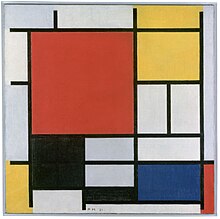Featured
- Get link
- X
- Other Apps
Rhythm
Jean Metzinger's mosaic-like Divisionist technique had its parallel in literature; a characteristic of the alliance between Symbolist writers and Neo-Impressionist artists:
I ask of divided brushwork not the objective rendering of light, but iridescences and certain aspects of color still foreign to painting. I make a kind of chromatic versification and for syllables, I use strokes which, variable in quantity, cannot differ in dimension without modifying the rhythm of a pictorial phraseology destined to translate the diverse emotions aroused by nature. (Jean Metzinger, circa 1907)[16]
Rhythm, for artists such as Piet Mondrian,[17][18] is important in painting as it is in music. If one defines rhythm as "a pause incorporated into a sequence", then there can be rhythm in paintings. These pauses allow creative force to intervene and add new creations—form, melody, coloration. The distribution of form or any kind of information is of crucial importance in the given work of art, and it directly affects the aesthetic value of that work. This is because the aesthetic value is functionality dependent, i.e. the freedom (of movement) of perception is perceived as beauty. Free flow of energy, in art as well as in other forms of "techne", directly contributes to the aesthetic value.[17]
You received this message because you are subscribed to the Google Groups "2top-manitotasy-3" group.
To unsubscribe from this group and stop receiving emails from it, send an email to 2top-manitotasy-3+unsubscribe@googlegroups.com.
To view this discussion on the web visit https://groups.google.com/d/msgid/2top-manitotasy-3/CADVsWijKqjA%3D4DSSRh048JtODN9x26nM2NE15mKLWJSXhHXh2g%40mail.gmail.com.
- Get link
- X
- Other Apps

Comments
Post a Comment